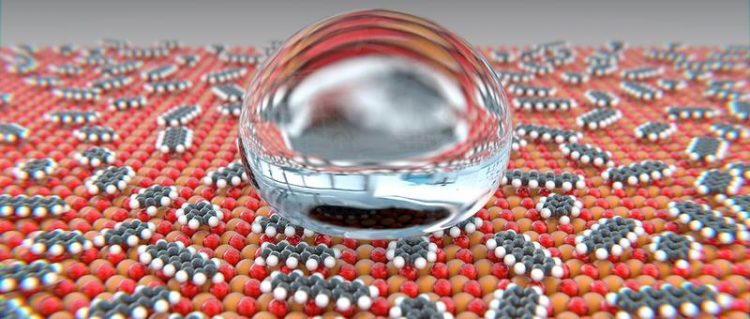Rare Earths Become Water-repellent Only as They Age

Rare earth oxides (red/orange) react with gaseous organic compounds. Through this reaction, the surface develops water-repelling properties. University of Basel, Department of Physics
Rare earths are metals found in rare earth minerals. They are used today in, among other things, automotive catalytic converters and batteries, in the production of screens and lamps, and as a contrast agent in magnetic resonance imaging. Their broad range of applications means that there is a high demand for rare earths, and this demand is constantly increasing.
Additional uses for rare earths were opened up after American researchers reported in 2013 that surfaces that have been coated with rare earth oxides become water-repellent.
Scientists from the University of Basel, the Swiss Nanoscience Institute and the Paul Scherrer Institute have now worked with the company Glas Trösch to examine these hydrophobic properties more closely.
Water-repellency develops only after chemical reactions
The researchers coated glass pieces with rare earth oxides, nitrides and fluorides and analyzed how well they could be wetted with water.
They could not detect any hydrophobic properties when the coating was freshly deposited. It was only chemical reactions with gaseous hydrocarbons found in the ambient air that increased the surfaces’ roughness and reduced wetting by water.
The gaseous organic compounds from the ambient air are first adsorbed by the surface and then react with the oxides to form carbonates and hydroxides until the surface is completely covered with these compounds. This process takes place even at room temperature.
“We were surprised that the hydrophobic effect was caused by the surface aging,” says Professor Ernst Meyer, from the Department of Physics at the University of Basel, commenting on the results of the project supported by the Commission for Technology and Innovation (CTI).
These conclusions are very revealing from a scientific point of view because catalytic processes also frequently take place at room temperature, which makes it important to understand the surface’s physical properties.
The examined materials are, however, unsuitable for the industrial production of water-repellent glass surfaces, because the glass requires a sophisticated storage process before it shows the desired hydrophobic characteristics.
Original source
Elçin Külah, Laurent Marot, Roland Steiner, Andriy Romanyuk, Thomas A. Jung, Aneliia Wäckerlin, & Ernst Meyer
Surface chemistry of rare-earth oxide surfaces at ambient conditions: reactions with water and hydrocarbons
Scientific Reports (2017), doi: 10.1038/srep43369
Further information
Prof. Dr. Ernst Meyer, University of Basel, Department of Physics, tel. +41 61 207 37 24, email: ernst.meyer@unibas.ch
Prof. Dr. Thomas A. Jung, University of Basel, Department of Physics, tel. +41 56 310 45 18, email: thomas.jung@psi.ch
Media Contact
All latest news from the category: Physics and Astronomy
This area deals with the fundamental laws and building blocks of nature and how they interact, the properties and the behavior of matter, and research into space and time and their structures.
innovations-report provides in-depth reports and articles on subjects such as astrophysics, laser technologies, nuclear, quantum, particle and solid-state physics, nanotechnologies, planetary research and findings (Mars, Venus) and developments related to the Hubble Telescope.
Newest articles

Innovative vortex beam technology
…unleashes ultra-secure, high-capacity data transmission. Scientists have developed a breakthrough optical technology that could dramatically enhance the capacity and security of data transmission (Fig. 1). By utilizing a new type…

Tiny dancers: Scientists synchronise bacterial motion
Researchers at TU Delft have discovered that E. coli bacteria can synchronise their movements, creating order in seemingly random biological systems. By trapping individual bacteria in micro-engineered circular cavities and…

Primary investigation on ram-rotor detonation engine
Detonation is a supersonic combustion wave, characterized by a shock wave driven by the energy release from closely coupled chemical reactions. It is a typical form of pressure gain combustion,…



